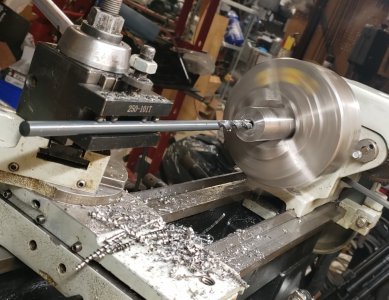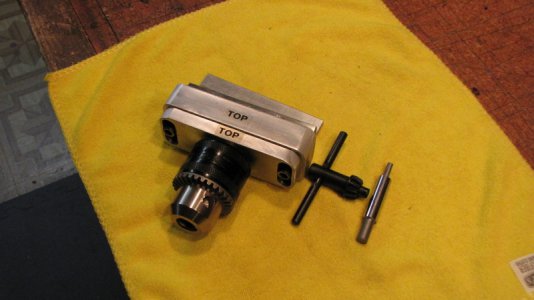- Joined
- Oct 29, 2012
- Messages
- 1,328
Probably this is one the oldest tricks in the book and I've just managed to browse past every video that demonstrates it. I just figured it out today after years of fussing with the tailstock so I figured I would share. It's a huge a time saver for drilling deep holes, especially if your tailstock locks down with a bolt instead of a cam.
My tailstock only has 2.25" of travel so after the first 2" I would be retracting the tailstock, turning a wrench to unlock the tailstock, pulling it back to clear chips, sliding it back into the hole, turning a wrench to lock it back down, and then advancing the tailstock to drill deeper; that's about 45 seconds worth of non-productive drudgery for every 10 seconds of advancing the bit and making the hole deeper.
Doing it as demonstrated below you just run the carriage back and forth and forget all about the tailstock.

I set the drill bit in position by drilling about an inch into the workpiece using the tailstock. Then, turn off the spindle and with the bit still held in the tailstock Chuck and still engaged into the workpiece, bring the compound in with an empty tool holder and adjust the tool holder height knob until the bottom of the tool holder touches the bit. Then lock the tool holder down and tighten down the grub screws. Once the drill bit is secured in the tool holder, release it from the tailstock Chuck and get the tailstock out of the way. Finish the job by running the carriage in and out until you bore all the way through.
You should also be able to do this without ever touching the tailstock, if before loading your workpiece, load the drill bit into your spindle's chuck and tighten, then clamp onto the protruding bit with your empty tool holder as described above. Theoretically your drill bit is now perfectly aligned with the spindle axis. I haven't tried this method but it works in my head.
My tailstock only has 2.25" of travel so after the first 2" I would be retracting the tailstock, turning a wrench to unlock the tailstock, pulling it back to clear chips, sliding it back into the hole, turning a wrench to lock it back down, and then advancing the tailstock to drill deeper; that's about 45 seconds worth of non-productive drudgery for every 10 seconds of advancing the bit and making the hole deeper.
Doing it as demonstrated below you just run the carriage back and forth and forget all about the tailstock.

I set the drill bit in position by drilling about an inch into the workpiece using the tailstock. Then, turn off the spindle and with the bit still held in the tailstock Chuck and still engaged into the workpiece, bring the compound in with an empty tool holder and adjust the tool holder height knob until the bottom of the tool holder touches the bit. Then lock the tool holder down and tighten down the grub screws. Once the drill bit is secured in the tool holder, release it from the tailstock Chuck and get the tailstock out of the way. Finish the job by running the carriage in and out until you bore all the way through.
You should also be able to do this without ever touching the tailstock, if before loading your workpiece, load the drill bit into your spindle's chuck and tighten, then clamp onto the protruding bit with your empty tool holder as described above. Theoretically your drill bit is now perfectly aligned with the spindle axis. I haven't tried this method but it works in my head.



